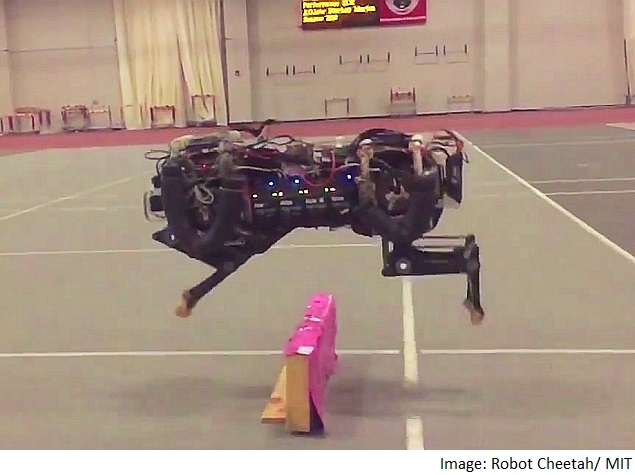- Home
- Science
- Science News
- MIT's Cheetah Robot Can Now Leap Over Obstacles
MIT's Cheetah Robot Can Now Leap Over Obstacles

MIT researchers have trained their cheetah robot to jump over hurdles as it runs - making it the first four-legged robot that can run and jump over obstacles autonomously.
The Massachusetts Institute of Technology researchers had demonstrated last year that the robotic cheetah was able to run untethered.
The feat was performed by the robot without the use of cameras or other vision systems.
Now, the robot can 'see', with the use of onboard LIDAR - a visual system that uses reflections from a laser to map terrain.
The researchers developed a three-part algorithm to plan out the robot's path, based on LIDAR data. Both the vision and path-planning system are onboard the robot, giving it complete autonomous control.
To get a running jump, the robot plans out its path, much like a human runner: As it detects an approaching obstacle, it estimates that object's height and distance.
The robot gauges the best position from which to jump, and adjusts its stride to land just short of the obstacle, before exerting enough force to push up and over.
Based on the obstacle's height, the robot then applies a certain amount of force to land safely, before resuming its initial pace.
In experiments on a treadmill and an indoor track, the cheetah robot successfully cleared obstacles up to 18 inches tall - more than half of the robot's own height - while maintaining an average running speed of 8 km per hour.
The team tested the MIT cheetah's jumping ability first on a treadmill, then on a track. On the treadmill, the robot ran tethered in place, as researchers placed obstacles of varying heights on the belt.
As the treadmill itself was only about 4 metres long, the robot, running in the middle, only had 1 metre in which to detect the obstacle and plan out its jump.
After multiple runs, the robot successfully cleared about 70 percent of the hurdles.
In comparison, tests on an indoor track proved much easier, as the robot had more space and time in which to see, approach, and clear obstacles. In these runs, the robot successfully cleared about 90 percent of obstacles.
The team is now working on getting the MIT cheetah to jump over hurdles while running on softer terrain, like a grassy field.
Get your daily dose of tech news, reviews, and insights, in under 80 characters on Gadgets 360 Turbo. Connect with fellow tech lovers on our Forum. Follow us on X, Facebook, WhatsApp, Threads and Google News for instant updates. Catch all the action on our YouTube channel.
Related Stories
- Samsung Galaxy Unpacked 2025
- ChatGPT
- Redmi Note 14 Pro+
- iPhone 16
- Apple Vision Pro
- Oneplus 12
- OnePlus Nord CE 3 Lite 5G
- iPhone 13
- Xiaomi 14 Pro
- Oppo Find N3
- Tecno Spark Go (2023)
- Realme V30
- Best Phones Under 25000
- Samsung Galaxy S24 Series
- Cryptocurrency
- iQoo 12
- Samsung Galaxy S24 Ultra
- Giottus
- Samsung Galaxy Z Flip 5
- Apple 'Scary Fast'
- Housefull 5
- GoPro Hero 12 Black Review
- Invincible Season 2
- JioGlass
- HD Ready TV
- Laptop Under 50000
- Smartwatch Under 10000
- Latest Mobile Phones
- Compare Phones
- Realme P4x 5G
- OnePlus Ace 6T
- OPPO A6x 5G
- Samsung Galaxy Z TriFold
- Poco F8 Ultra
- Poco F8 Pro
- Huawei Mate 80 RS Master Edition
- Huawei Mate 80 Pro Max
- Asus ProArt P16
- MacBook Pro 14-inch (M5, 2025)
- Poco Pad M1
- Poco Pad X1
- Just Corseca Skywatch Pro
- Honor Watch X5
- Acerpure Nitro Z Series 100-inch QLED TV
- Samsung 43 Inch LED Ultra HD (4K) Smart TV (UA43UE81AFULXL)
- Asus ROG Ally
- Nintendo Switch Lite
- Haier 1.6 Ton 5 Star Inverter Split AC (HSU19G-MZAID5BN-INV)
- Haier 1.6 Ton 5 Star Inverter Split AC (HSU19G-MZAIM5BN-INV)
-
 NotebookLM App Gets an In-Built Camera, Lets Users Upload Images as a Source
NotebookLM App Gets an In-Built Camera, Lets Users Upload Images as a Source
-
 HMD 101 Launched in India With 1,000mAh Battery, Auto Call Recording Alongside HMD 100: Price, Features
HMD 101 Launched in India With 1,000mAh Battery, Auto Call Recording Alongside HMD 100: Price, Features
-
 Crypto Traders Await US Fed Signals as Bitcoin Price Drops to $91,900
Crypto Traders Await US Fed Signals as Bitcoin Price Drops to $91,900
-
 Nothing Phone 3a Lite Goes on Sale in India: See Price, Offers, Availability
Nothing Phone 3a Lite Goes on Sale in India: See Price, Offers, Availability












